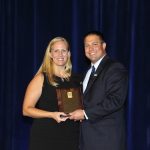By: Lisa Murray, APR, CPRC – SWFL Chapter (Twitter: @iamlisadanielle)
Carolyn Maue, executive coach, consultant, and president of The Maue Center believes that strong leaders have the ability to inspire and drive positive change for their organizations, families and communities. Carolyn, along with her longtime friend and colleague, Carol Bennett, also an executive coach for The Maue Center, discussed how attendees could design their unique leadership path during one of the first breakout sessions of FPRA’s 80thAnnual Conference.
So what is leadership? Carolyn began the session by putting this question into context through the words of author and businessman Kevin Kruse, who said:
“Leadership is a process of social influence, which maximizes the efforts of others, towards the achievement of a goal.”
Diving further into the context of Kruse’s quote, she provided these key takeaways:
- Leadership stems from social influence, not authority or power
- Leadership requires others, and that implies they don’t need to be “direct reports”
- No mention of personality traits, attributes, or even a title; there are many styles, many paths, to effective leadership
- It includes a goal, not influence with no intended outcome
Carolyn and Carol each shared their expertise as they outlined eight steps of personal reflection to consider when designing a unique leadership path. Carol emphasized that each of us has our own idea of what leadership is. For her, leadership means empowering others. She stressed that leadership does not only apply to your business or profession; you can take these leadership traits and use them in all aspects of your life.
Reflection #1 – Goal
What is a goal that you’d like to achieve in the next several years?
Reflection #2 – Strengths
What are the strengths that you bring to your organization?Review the list of leadership strengths below and identify yourthree leadership strengths and three professional gifts/talents/aptitudes
Knowledge & Wisdom
- Creativity
- Curiosity
- Love of learning
- Wisdom/perspective
- Open-mindedness
Courage & Firmness
- Bravery
- Persistence
- Integrity
- Vitality
Humanity & Love
- Give and receive love
- Kindness
- Social intelligence
Justice & Fairness
- Citizenship
- Fairness
- Leadership
Temperance
- Forgiveness
- Modesty/humility
- Prudence
- Self-regulation
Transcendence/Spiritual
- Appreciation of excellence and beauty
- Gratitude
- Hope
- Humor
- Spirituality
Strengths – The building blocks
Your strengths can be used as building blocks to design your unique leadership path!
- Happier and more confident
- Higher levels of self esteem and energy
- Experience less stress and more resilience
- More likely to achieve goals
- Perform better and more engaged at work
- Develop skills quicker when using strengths
Reflection #3 – Flower
- Draw a flower with petals
- The center of the flower is your core – these are your strengths, your talents, character, skills, knowledge, and values.
- The petals on the flower are the different domains in your life.
- Label each petal
- Note the aspects of your life/work where your strengths, talents and skills are showing up the most.
- Where are they showing up the least?
Drawing enacts/stimulates a different part of your brain separate from coloring the drawing, explaining the drawing, etc.
Reflection #4 – Aspiration
Identify three people whose leadership you admire, in any aspect of your life (living or deceased). Then pick your favorite and answer the following questions:
- What is it that you most admire about this person (behaviors, knowledge, etc.)?
- What are their values and how do they convey them?
- What is it that resonates with you?
Both Carolyn and Carol say that one of the most important parts of influence is thinking about the people that you admire most and picking out what it is about them that resonates with you. For example, the person could be a family member, a mentor at work, or a spiritual advisor. Ask yourself what their values are and how they display them? How could you incorporate that into your own life to influence others?
Reflection #5 – Influence
In what ways are you influential?
- I am responsive
- I am focused on the group
- I am satisfied by intrinsic rewards
- I see things through a new filter
- I am adaptable
- I am not judgmental
- I motivate people in positive ways
Reflection #6 – Influence and Purpose
- Given your strengths, talents and aspirations, where can you have the most impact?
- How can you increase your influence in ways that are unique to you?
Reflection #7 – Keeping Your Energy Up
- What support your peak performance and keeps your energy up?
- What de-energizes and drains you?
- What are 5 things you are “tolerating” in your life?
Reflection #8 – Go Back to Your Flower
Pick a pedal to focus on for this next exercise.
- Where do you see a gap between the leadership you admire and your own leadership in this area?
- What are the obstacles?
- Name one step you can take to close the gap.
After going through the reflection exercise, Carolyn recommends using the following steps to help you reach your goal and celebrate your accomplishment.
- Your strengths
- Commit to one step
- Barriers and de-energizers
- Ask for help
- Celebrate
- Write a press release on how you magnificently reached your goal!
Finding an accountability partner will also help you be accountable along your way to designing your unique leadership path!



